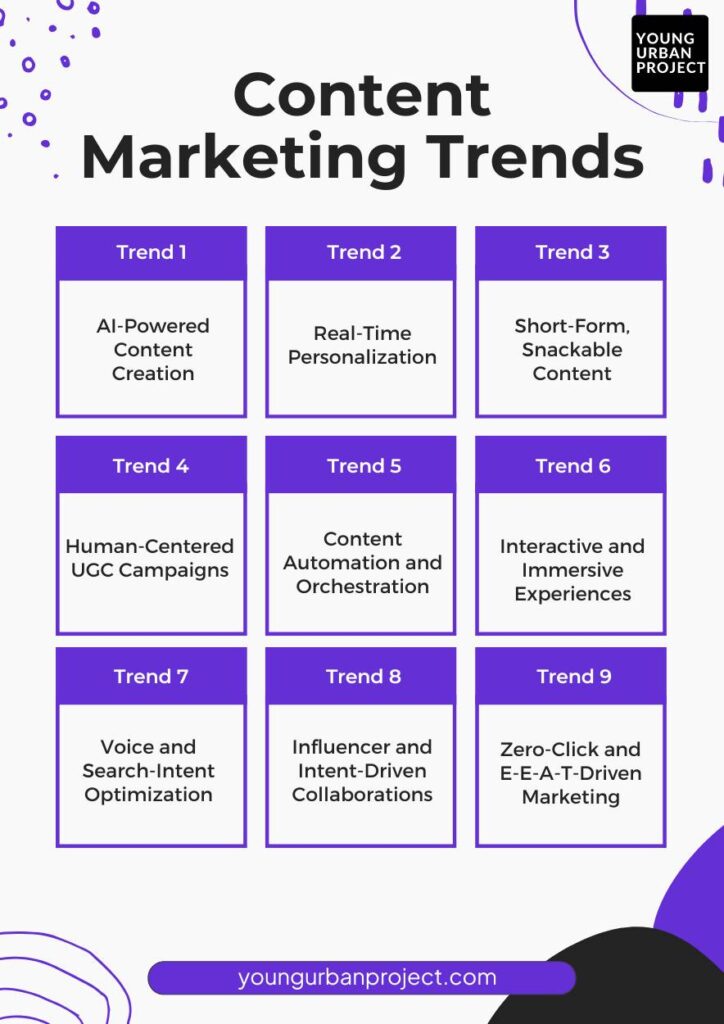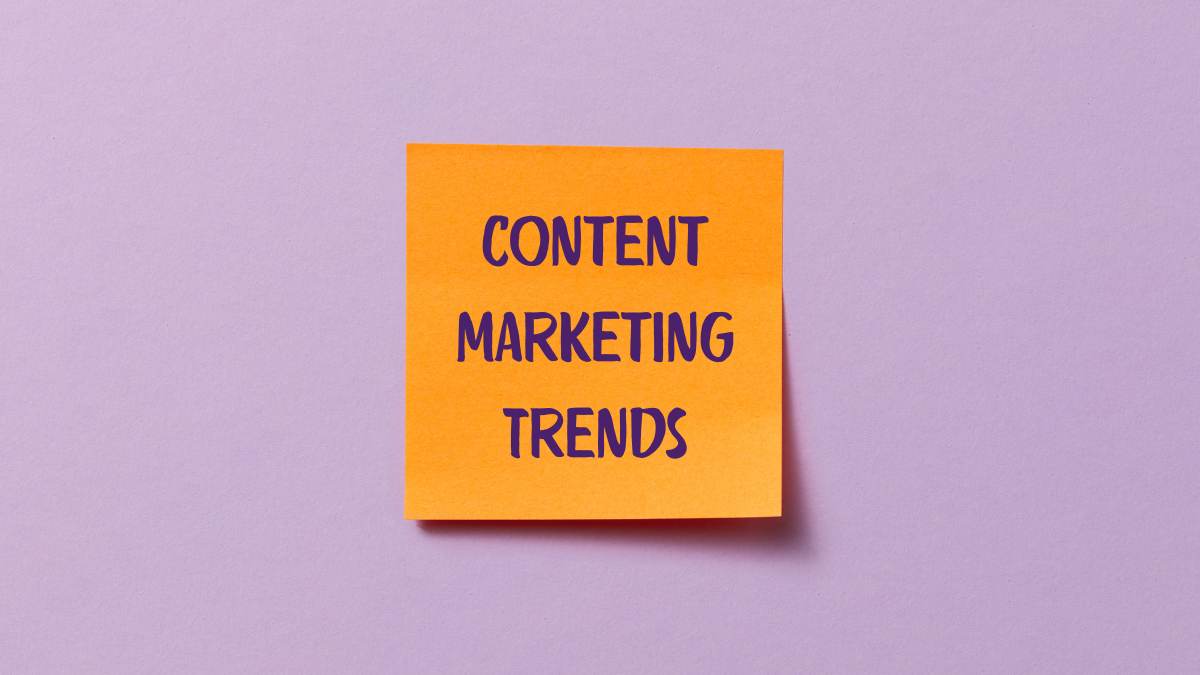Table of Contents
Why Content Marketing Still Matters
Every couple of years someone declares that content marketing is “done.” And yet here we are in 2025, and it’s still one of the biggest growth areas for brands. If anything, it’s stronger.
Content marketing, at its simplest, is just… telling stories, sharing knowledge, creating things people actually want to consume instead of blasting them with ads. It drives awareness, brings in leads, and builds loyalty in a way traditional ads usually can’t.
And the reality is this: people don’t always meet your brand through a paid campaign anymore. Their first touchpoint is often a blog post they stumbled across on Google, or a short video that popped up on TikTok, or maybe a friend’s Instagram story. That’s why companies are spending more; content isn’t just “extra,” it’s the first handshake.
Key Benefits of Content Marketing in 2025
1. Traffic That Doesn’t Disappear Overnight
When you publish a strong piece of content, let’s say a guide or a video that answers a burning question, it doesn’t vanish the way a paid ad does when the budget runs out. It keeps pulling people in. That’s why content marketing is such a smart long-term play.
2. Better Returns Than Old-School Ads
Advertising works, but it’s expensive. And it stops the second you stop paying. Content, on the other hand, is more like an investment. You build it once, and if it’s good, it keeps paying off. That’s why more marketers are shifting budget toward it, it just stretches further.
3. Authority, Credibility, and Trust
Anyone can say “we’re the best” in an ad. But when you consistently share useful, researched, insightful content, people start to believe you actually know what you’re talking about. That trust compounds. And yes, search engines pick up on it too.
4. Conversions That Feel Natural
It’s not just about attracting eyeballs anymore. Personalized landing pages, segmented email flows, and even product recommendations woven into content they all turn content into a conversion machine. The key is relevance. When it feels like the content was made for me, I’m more likely to act.
Also Read: How Storytelling in Content Marketing Triggers the Brain
Types of Content Marketing You Can’t Ignore
The formats shift every year, but a few types are clearly leading the way right now.
1. Blogs and Long-Form Content
Blogs aren’t dead. If anything, they’re evolving. Long, detailed posts still dominate in SEO, and they show your expertise better than a 30-second clip ever could. They’re slower to consume, but for the right audience, they’re gold.
2. Short-Form Content
Reels, TikToks, YouTube Shorts, they’re everywhere, and they work. They’re quick, they’re shareable, and they’re addictive. Alone, they might not build deep trust, but they keep you in people’s minds daily.
3. Video
Video continues to be the most versatile format. It entertains, teaches, and humanizes a brand all at once. YouTube is still massive, but TikTok and Instagram are driving the bulk of discovery for younger audiences.
4. User-Generated Content
People trust other people more than brands. Reviews, testimonials, or just casual social posts from real customers carry enormous weight. UGC campaigns also make audiences feel part of the brand story.
5. Email Newsletters
Newsletters are back in style. The good ones feel less like promotions and more like curated updates you actually want to open. Pair that with automation and you’ve got one of the most cost-effective nurturing channels.
6. Interactive Content
Polls, calculators, quizzes, they’re fun, they’re memorable, and they give you data on what your audience cares about. Unlike static blogs, interactive pieces make people stick around longer.
Also Read: Performance Marketing Trends
The Top Content Marketing Trends Shaping 2025

Every year, the “rules” of content shift a little. Sometimes it’s a platform update, sometimes it’s just how people change the way they consume stuff online. 2025 isn’t about brand-new inventions; it’s more about certain ideas finally sticking and others fading out. Some of these are obvious, some less so, but all of them matter if you care about staying relevant.
1. AI-Powered Content Creation
Like it or not, AI is here to stay in content. It’s not replacing good marketers, but it’s definitely making the job quicker. People are using it to brainstorm topics, draft outlines, maybe even write a rough first version. The danger is leaning too hard on it; you can tell when something is written by a machine. There’s no soul. The winning formula seems to be: let AI handle the heavy lifting, then polish it so it actually feels human. Brands that do this well can move faster without sounding cookie-cutter.
2. Real-Time Personalization
Personalization isn’t “Hi [First Name]” anymore. That’s old news. In 2025, personalization means showing people content that actually matches where they are in their journey, in the moment. Maybe it’s a landing page that shifts based on what someone just clicked, or an email that updates depending on what product they looked at yesterday. Done well, it feels seamless. Done poorly, it feels creepy. The companies getting it right are the ones that balance usefulness with respect for the user.
3. Short-Form, Snackable Content
This isn’t exactly new, but short-form still dominates. TikTok, Reels, Shorts, people want quick hits of content they can watch in a spare minute. The risk is thinking short-form is all you need. It’s not. It’s more like the hook. You grab attention with a 15-second clip, but you need something bigger behind it, blogs, podcasts, long videos, for when people want to go deeper. Think of short-form as the spark, not the fire.
4. Human-Centered UGC Campaigns
User-generated content has always worked because people trust other people more than they trust brands. But the game has changed, UGC now isn’t just “share our hashtag.” Brands are creating campaigns that encourage real participation. Challenges, contests, collabs. The best part? It feels authentic, not polished. A selfie review or unfiltered product demo from a real customer will beat a glossy ad almost every time.
5. Content Automation and Orchestration
Here’s where most teams struggle: you’ve got tons of content, but it’s scattered, inconsistent, or gets posted late. Automation tools have gotten way better at handling that mess. You can plan, schedule, and repurpose across platforms without burning out. But here’s the warning, automation can’t replace judgment. If you push out 20 posts that feel robotic, people tune out. The balance is automation for consistency, human oversight for personality.

Enroll Now: Advanced Digital Marketing Course
6. Interactive and Immersive Experiences
People are tired of passively scrolling. That’s why interactive content, quizzes, calculators, polls, is so sticky. It pulls people in, gives them something to do. And it doesn’t just entertain, it gives brands data they can actually use. We’re also seeing longer interactive stuff, like digital guides with videos and tools built in. It’s like the difference between reading a textbook and playing a game, you remember the interactive one.
7. Voice and Search-Intent Optimization
Search isn’t just text anymore. More people are talking to their devices, asking full questions, and expecting natural answers. That means content needs to match how people speak, not just how they type. At the same time, search engines (and AI-driven search results) are getting better at understanding intent. So instead of stuffing in keywords, you need to think: is the user looking for info? A product? A step-by-step guide? Matching that intent is half the battle.
8. Influencer and Intent-Driven Collaborations
Influencer marketing has matured. It’s not about the biggest name anymore, it’s about the right fit. Smaller creators with niche, engaged audiences can drive more results than a celebrity with millions of passive followers. The best collaborations now feel authentic: co-created content, long-term partnerships, stuff that doesn’t scream “sponsored.” Audiences can sniff out fake endorsements instantly, so alignment matters more than ever.
9. Zero-Click and E-E-A-T-Driven Marketing
This one stings a bit. More and more, Google and other platforms are giving answers directly on the results page, so users don’t always click through to your site. That’s the reality now. The only way to stay in the game is to make sure your brand is the answer. That means focusing on trust, credibility, and authority. If your content is clear, accurate, and backed by expertise, it has a better shot at being featured. Even if it doesn’t bring a direct click, it builds visibility and authority.
Also Read: Latest Trends in Digital Marketing
Data and Insights: Content Marketing in Numbers
Content marketing in 2025 isn’t slowing down, it’s still growing fast, and the data makes that clear. Engagement, AI adoption, and budgets are all moving upward, though B2B and B2C don’t always see the same results.
Traffic and Engagement Trends
- 72% of marketers say their content strategy boosted both engagement and traffic this year. (Source)
- 53% of marketers are tracking social media and website engagement as their top success metric. (Source)
- Interactive content stands out, showing a 52.6% higher engagement rate than static pieces. On average, buyers still spend about 8.5 minutes on static assets. (Source)
AI Adoption Rates and Effectiveness
- 88% of digital marketers now use AI in daily work, while 80% worldwide are already weaving AI tools into their strategy. (Source)
- 92% of businesses plan to invest in generative AI tools within the next three years. (Source)
- The AI market for marketers is valued at $47.32 billion in 2025, and generative AI is projected to climb to $356.05 billion by 2030. (Source)
- Main reasons for adopting AI: efficiency, better personalization, and support for smarter decisions.
Confidence Levels: B2C vs B2B
- 43.3% of B2C marketers report high success with their strategies, but only 32% of B2B marketers say the same. (Source)
- Overall confidence in content marketing actually dipped by 2.3% year over year, mostly because B2B marketers face tougher niches and rising quality expectations. (Source)
Trends in Link Building, Outsourcing, and Resources
- About half of marketers outsource parts of their content marketing, showing the demand for specialized expertise. (Source)
- Nearly 50% of marketers plan to increase their content budgets in 2025, while 41% expect budgets to stay flat. (Source)
- For B2B marketers specifically, the biggest investments are going into video (61%) and thought leadership (52%). (Source)
The takeaway? 2025 content marketing is being shaped by rapid AI adoption, proven engagement gains, and a clear split in confidence between B2C and B2B. The pressure is on brands to use data-backed, high-quality strategies if they want to stay competitive.
Also Read: Social Media Trends Every Brand Must Know
How to Implement These Trends Effectively
Reading about trends is one thing. Actually doing something with them is the harder part. Most teams try to chase everything at once and end up doing none of it well.
1. Start With the Audience
Sounds obvious, but most brands skip it. Instead of guessing, actually look at what your audience is searching for, what they comment on, what gets shared. Ask them, even. Content that solves their problems will always perform better than content that just checks a trend box.
2. Use Tools, But Don’t Lose the Human Side
Automation is great for scheduling, for repurposing, for cutting down the grunt work. But when everything feels robotic, people scroll right past. The mix that works is: use tools to save time, then add the human voice back in. Personality, opinion, even imperfection, that’s what makes content stick.
3. Track the Right Stuff
It’s easy to brag about likes and impressions. But the real question is: did this piece bring in leads, signups, or sales? Did it actually build trust with the right people? Those are the numbers that matter, and if you’re not measuring them, it’s easy to get lost.
4. Keep Updating, Don’t Just Post and Forget
Even your best blog post or video has a shelf life. Algorithms change, audience expectations shift. Go back, update, refresh, republish. Turn a blog into a reel, or a podcast into a LinkedIn post. The brands who keep their content alive are the ones who see long-term results.
Also Read: Latest SEO Trends
Common Mistakes to Avoid in 2025
Even with all the tools and shiny new trends, content marketing still has its pitfalls. I see the same mistakes pop up again and again.
1. Relying too much on AI
Yes, it’s efficient. Yes, it speeds up content creation. But when everything starts sounding the same, audiences tune out. If you’re not layering in real human stories, examples, or some genuine voice, it’s just noise.
2. Ignoring SEO and search intent
This one hasn’t changed much over the years. You can write a great blog post, but if it doesn’t match what people are actually searching for, or the way they search now, especially with voice and AI search, you’re invisible.
3. Skipping personalization
Sending generic emails or creating generic content isn’t enough anymore. The tools are there to make experiences feel more tailored, and people notice when you don’t bother.
4. Overlooking UGC and influencers
Brands that underestimate the power of other people talking about them are leaving a lot on the table. People trust people more than logos. If you’re not encouraging participation or partnering with the right voices, you’re missing out on credibility and reach.
Also Read: Marketing Automation Trends
Wrapping Up: The Future of Content Marketing
If I had to sum it up, I’d say content marketing in 2025 feels like both evolution and correction. We’re doubling down on formats that work, like video, long-form articles, and interactive stuff, while finally admitting that some things (like endless short blogs with no value) don’t cut it anymore.
Looking ahead, I think the lines between content, community, and product will blur even more. Content won’t just promote, it will become part of the experience. Think tools, calculators, interactive guides that people keep coming back to, not just one-and-done campaigns.
The main takeaway? Stay flexible. Experiment. And don’t assume what worked last year will carry you forward forever. Trends move fast, but the core never changes: create something that actually helps people.
FAQ: Content Marketing Trends 2025
What are the top content marketing trends in 2025?
Video, long-form blogs, interactive content, personalization, and smart use of AI are leading the way. UGC and influencer collaborations are also proving huge for trust and reach.
How is AI changing content marketing?
It’s mostly about speed and efficiency, helping with research, drafting, and even distribution. But the magic happens when humans edit, refine, and add real perspective.
Why is personalization crucial for content strategy?
Because audiences are drowning in content. Personalized recommendations, tailored emails, and dynamic landing pages break through the noise and make people feel seen.
How can I measure the ROI of interactive content?
Look at engagement metrics first, time spent, clicks, shares, completions of a quiz or calculator. Then map those actions to conversions, whether that’s email signups, product demos, or sales.
What is Generative Engine Optimization (GEO)?
It’s basically optimizing your content for AI search results and answer engines, not just Google’s blue links. That means clear, direct answers, strong authority signals, and content structured in a way AI can pull from easily.

